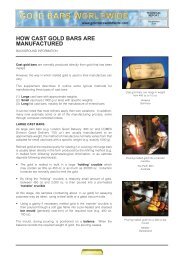Indian Gold Book:Indian Gold Book - Gold Bars Worldwide
Indian Gold Book:Indian Gold Book - Gold Bars Worldwide
Indian Gold Book:Indian Gold Book - Gold Bars Worldwide
You also want an ePaper? Increase the reach of your titles
YUMPU automatically turns print PDFs into web optimized ePapers that Google loves.
GOLD MINING AND EXPLORATION<br />
For 36 years (1957-1993), the mining of gold was nationalised under the Mines & Minerals (Regulation<br />
& Development) Act 1957.<br />
In line with the <strong>Indian</strong> government’s policy of economic deregulation initiated in 1991, a new National Mineral Policy<br />
was announced in March 1993. Alongside 12 other minerals, the mining of gold was liberalised to include private<br />
initiatives.<br />
The new policy is designed to encourage the development and exploitation of the country’s mineral resources, focusing<br />
on those minerals, such as gold, where there is a disparity between domestic supply and demand.<br />
Although current annual gold mine output is only around 2 tonnes, there are many gold exploration projects. More than<br />
20 million tonnes of proven, probable and possible gold ore reserves have now been identified.<br />
PRIMARY GOLD PRODUCERS<br />
The original Act, renamed the Mines and Minerals (Development and Regulation) Act 1957, was amended in<br />
January 1994 and December 1999.<br />
Restrictions on foreign equity participation have been removed. More powers have been given to State governments to<br />
grant, renew and transfer mineral concessions. Area restrictions have also been liberalised to apply to a single State, not<br />
the country as a whole. For example, in each State, a Reconnaissance Permit can now cover 10,000 square kilometres, a<br />
Prospecting Licence 25 square kilometres, and a Mining Lease 10 square kilometres.<br />
Two companies mine primary gold in India. The mines are located in two States in the south: Karnataka and Andhra<br />
Pradesh.<br />
The Hutti <strong>Gold</strong> Mines Co Ltd (HGML)<br />
Established in 1947, but known as Hutti <strong>Gold</strong> Mines since 1956. An undertaking of the Karnataka State Government under<br />
the administrative control of the Department of Commerce and Industry.<br />
Mines: Located in Karnataka. Hutti (in the Raichur district) and Mangalur (in the Gulburga district).<br />
Annual gold output is around 2 tonnes.<br />
M/s Bharat <strong>Gold</strong> Mines Ltd (BGML)<br />
Incorporated in 1972. A Public Sector Undertaking under the administrative control of the Ministry of Coal and Mines.<br />
Mines: Located in the Kolar <strong>Gold</strong> Field in Karnataka, and in the Anantapur and Chittoor districts of Andhra Pradesh.<br />
Current annual gold output is less than 100 kg, following the closure of several mines in the Kolar <strong>Gold</strong> Field in 2000.<br />
SECONDARY GOLD PRODUCERS<br />
Two other companies produce gold as a by-product from copper slimes and concentrates. The smelters are<br />
located in Bihar in the east and Gujarat in the west.<br />
M/s Hindustan Copper Ltd (HCL)<br />
Incorporated in 1967. A Public Sector Undertaking under the administrative control of the Ministry of Coal and Mines.<br />
Smelter: Located at Ghatsala in the Singhbhum East district of Bihar.<br />
Annual gold output, as a by-product of copper slimes, has ranged between 400 - 700 kg.<br />
Indo-Gulf Corporation Ltd (Birla Copper)<br />
Part of the Birla Group of companies. The smelter, commissioned in May 1998, is located at Dehej in the Bharuch district<br />
of Gujarat.<br />
Annual gold output, as a by-product of imported copper concentrates, was 5.1 tonnes in its first year of production<br />
(2000-01).<br />
AN INTRODUCTION TO THE INDIAN GOLD MARKET 163

















